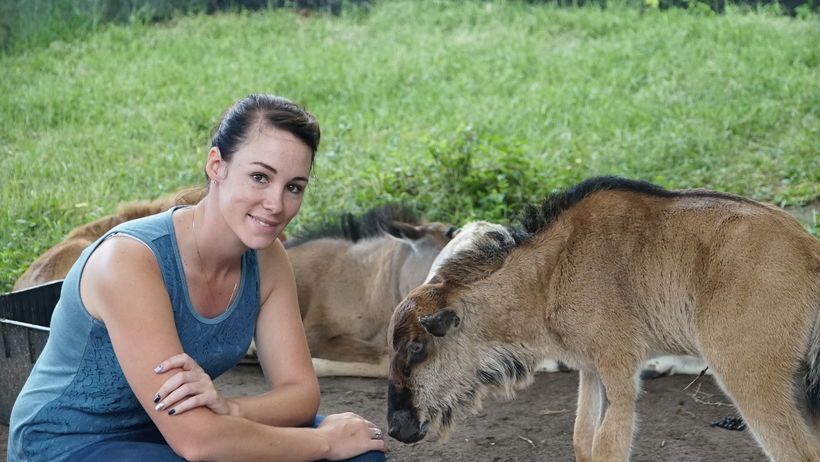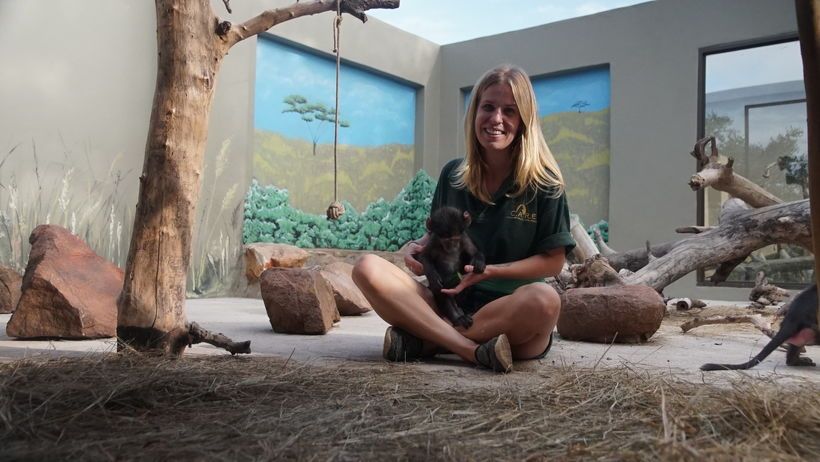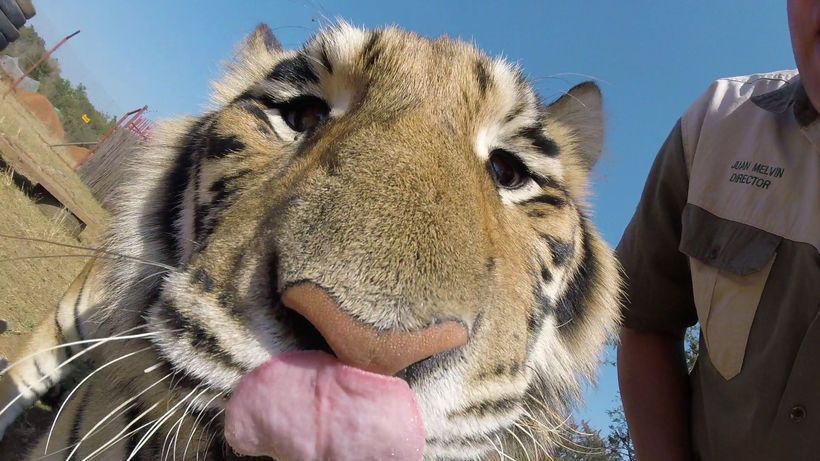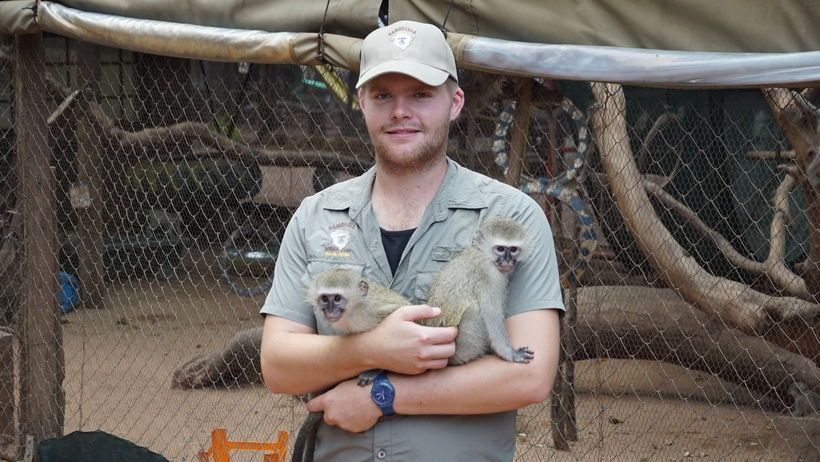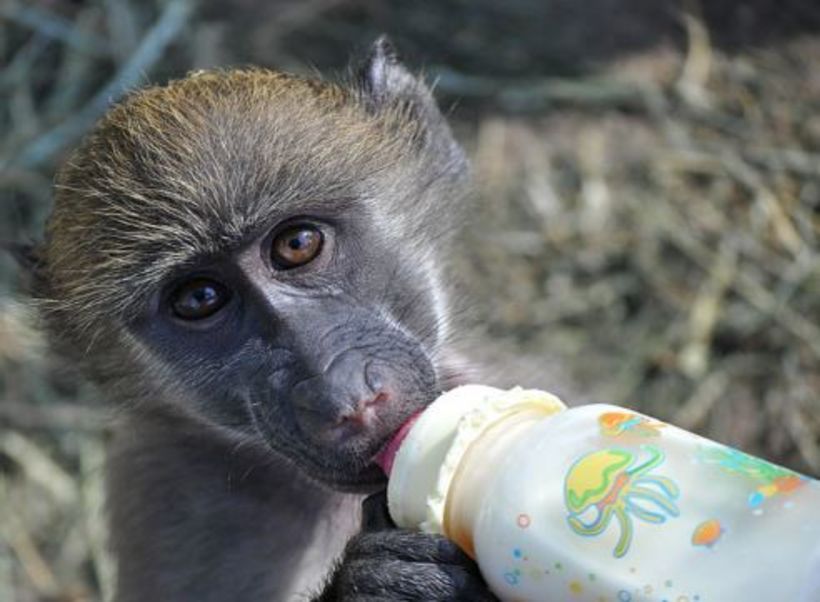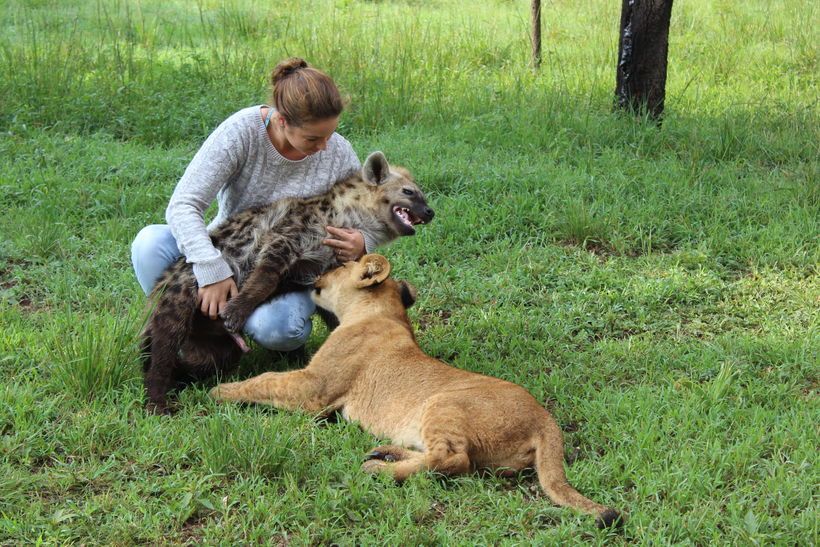Raising Wildlife
A heartwarming family series focusing on the work of animal specialists with their adopted animal babies.
When the dangers of the wild prove too much for these wounded animals, they are granted reprieve with foster parents who care for them as well as - and sometimes even better than - their natural parents. Get an intimate look at the daily routine of raising wildlife and experience exhilarating friendships between man and beast. Witness their challenges and the heart-warming moments encountered during rehabilitation. This series shows what it takes to care for these wild animals.
Episodes
-
Baboon, Cheetah, Bush baby
An orphaned baby baboon has enjoyed the love of its human foster mother at CARE, an emergency wildlife center. How will he respond when he meets his first baboon friend? This is an important milestone in becoming a member of a troop. Animal rescuers from the Wildlife Foundation in Namibia need to catch a young female cheetah in captivity; this is tricky and potentially dangerous work. Their plan is to reunite her with her mother so that she can learn how to function and survive in the wild. Bush babies are especially cute so sometimes they are kept as pets. The care givers at Riverside Wildlife Centre put emotions aside and prepare one for release in the wild.
-
Rhino, Hyrax, Porcupine
Rhino horn is more valuable than gold and more recent increases in poaching leaves the survival of this species at risk. Every day a rhino monitoring team at Somkhanda Game Reserve keeps track of a rhino and her calf, but skilful tracking and telemetry don’t guarantee that they’ll find them. When it comes to their milk feed, the competition is fierce for four orphaned baby dassies at Daktari Wildlife Orphanage. Their care taker forms strong bonds with the animals he looks after and decides to visit the rocky outcrop where he’s released a dassie – can he find his friend? A baby porcupine is hand-reared at Tenikwa Wildlife and Rehabilitation Centre. Can his surrogate mom teach him to forage; otherwise they won’t be able to release him back in the wild.
-
Elephant, Chimpanzee, Wildebeest
Raising wildlife can be a long-term commitment: elephant calves are dependent on their mothers for three years and chimpanzees rely on special attention for about seven. In this episode, we visit the Lilayi Elephant Nursery in Zambia and the Mefou Primate Park in Cameroon to meet the highly committed people who take on this responsibility. Night or day, a baby elephant can never be left alone and many of the chimpanzee orphans arrive highly traumatised. Their care givers need to work very hard to restore their trust and will to live. At the Kwaggasvlaktes Wildlife Centre in South Africa some baby Wildebeest rely on heart-warming help from humans and an unusual sheep to survive.
-
Penguin, Wildcat, Warthog
An African penguin chick has survived expulsion from the nest, but can surgery help an adult who’s been savaged by a seal to see the ocean again? All in a day’s job at the South African Marine Rehabilitation and Education Centre where a caregiver’s fingers also narrowly escape the razor-sharp beak of a gannet. Something stands in the way of a high spirited young caracal, but the Sondela Wildlife Centre are hatching a plan to secure his release back in the wild. Two baby warthogs at the Gitta Martula Rehabilitation Wildlife Centre still prefer their apples to their potatoes but, slowly and surely, they are being adjusted to living in their natural environment – the whole wild world awaits.
-
Wild dog, Baboon, Antelope
Rehabilitating and teaching young wild dog packs to hunt is what Margerita does at Erindi Private Game Reserve in Namibia. Margerita had discovered many of the wild dog packs in the region had succumb to illness and died. Margerita took it upon herself to raise an abandoned young pack of wild dogs. She teaches them to run as a pack, hunt as a pack and survive as a pack thus ensuring when the time comes the wild dog pack will survive in the wild. Alma’s passion for yellow baboons in Malawi brought her to the African continent to live-out her passion. Her daily chores, activities and inspections keep her busy. Two yellow baboons meet each other for the first time when the gate separating them is opened. One of South Africa’s smallest antelope known as a Cape Grys Bokkie loves playing hide ‘n seek it seems. When it comes to feeding the young antelope it always proves to be a challenge. However, this could be the nature of this timid little antelope.
-
Lion, Zebra, Wolf
Lindi, the one-eyed Lion cub lives at Wildthingz Lodge situated in the northern region of South Africa. Having one eye does not restrict Lindi from been a playful and energetic lion cub. Skabenga, a young Hyena, also lives at Wildthingz. Skabenga has almost become part of the family, and his bond to his caretaker cannot be denied. Wolves in Africa? Tsitsikamma Wolf Sanctuary is an orphanage to abandoned wolves. Raising wolves on the other hand is not always an easy job. This is the case with an energetic seven-month-old wolf, Raul who knows no boundaries. We meet Victor Hugo at Somkhanda where the motto is to keep all the animals wild while rehabilitating them. We will meet a herd of Zebra and their young and discover that the dynamics in the family group are not always what they seem. Victor also rescues a family of owl hatchlings and ensures their safety by building a new house in a nearby tree.
-
Vervet monkey, Cheetah, Kudu
It’s not surprising that raising the fastest animal on the planet involves regular exercise; Frank Kasakamula at the Ranch Conservancy in South Africa has a number of strategies in place for the cheetah in his care. A traumatised, orphaned baby Vervet monkey is especially clingy and demanding. But from nappy rash to night feeds, Dean Oakes at the Bambelela Wildlife Sanctuary takes everything involved in being a ‘good mother’ in his stride. Everyone at the Harnas Wildlife Foundation in Namibia has a right to life, including a blind, baby kudu named Derek. Soon his care taker, Louis Duvenhage, will introduce him to its new friends: a Springbok and a Duiker.
-
Grey Duiker, Silverback Gorilla
In the Centre for Rehabilitation of Wildlife situated in KwaZulu Natal, South Africa, junior nurse Kylie is preparing grey duiker Major for his release into the wild. Major had suffered several injuries when he arrived at the centre, but with Kylie’s help he recovered, and he will soon be back in his natural environment. We also travel to the Eastern Cape in South Africa to the main port city called, Port Elizabeth. Here Ruth, a dedicated animal caretaker, is constantly monitoring her loggerhead turtle hatchling Rocky, who has trouble with weight fluctuations. But once his nutrition is balanced enough that he can keep his weight for several weeks, he can be released into the Indian Ocean.Deep in the Cameroonian jungles we meet Rachel, a committed caretaker of primates at the Mefoue Primate Sanctuary. She arrived at the centre sixteen years ago and decided to stay after Khan Daniel, a new-born silverback gorilla, chose her as his surrogate mother. Since then her passion for these animals grew stronger from day to day. Sixteen years later Khan Daniel is the leader of the gorilla troop while Rachel now runs the private facility caring for these gentle giants of the forest.
-
Otters, Mongooses, Squirrel
In this episode, we travel to Howick in Kwa-Zulu Natal, South Africa to a Centre called FreeMe Wildlife Rehabilitation. Here we meet Kirsten, also known as ‘Otter Mom number 1’. Kirsten is training her three orphaned Otters how to swim and hunt. The three mammals, Juliet, Oberon and Othelloe have almost completed their rehabilitation. After preparing the release site for two weeks it is time to return the three siblings back into the river. But persuading them to leave their temporary home might be more of a challenge than Kirsten anticipated. Situated at the base of the Hlumu Hlumu Mountains in the province of Mpumalanga in South Africa we find DIY Wildlife Rehabilitation. Animal caretaker Mitch oversees many different animals at his sanctuary. He is preparing to transport and release a troop of Mongooses onto a new farm. Mongooses play a vital role in the region by keeping the snake population in balance. And in the summer season there are lots of them. So mobilizing the family quickly and efficiently is the first priority. A one-hour drive east of Johannesburg, at Wildlife, Judy is rehabilitating a one month old Squirrel. This tiny rodent has been kept as a pet and was malnourished. Judy constantly has to monitor his weight. But the little animal seems to become stronger and more confident because is obviously doesn’t want to be treated like a baby anymore. So Judy’s efforts pay off in the end.
-
White Rhino, Giant Pouched Rat, Bat
At the Hoedspruit Endangered Species Centre in the province of Limpopo we meet a member of one of the most threatened species on the planet, a white rhino named Esme. Caretaker Natasha is looking after the nine-month-old and makes sure it can develop in a well-protected surrounding. And she has got some help from a rather unexpected companion for the little calf - a dog named David. Further north we visit Tanzania, where so-called “Hero Rats” are fulfilling special tasks. These giant pouched rats are able to detect landmines and sniff out diseases. One of these little heroes named Sykwalker is learning how to detect tuberculosis. Caretaker Estadiov provides us an insight into the training of these extraordinary animals. In our highlight story, we meet Jane and her orphaned bat Devan. Rewild in Limpopo is the only Centre in the area that cares for and rehabilitates bats. Devan is having trouble with an essential skill for every bat – flying or more specifically the take-off. Because once he is airborne he seems to master the art of flight effortlessly.
-
Cheeta, Honey Badger, Blue Duiker
An hour’s drive from Johannesburg Warren is raising three cheetah cubs at the Lion and Cheetah Sanctuary. They are an endangered species – not only in South Africa but around the world. Warren is taking the three orphaned siblings for walks on a daily basis to give them the opportunity to experience being outside their enclosure. This is part of the preparation for their return to the wild. Convincing them to leave the enclosure is easy, trying to get them back in is a difficult task to undertake. In the South African Limpopo province, we meet clinic manager Nikita at the Moholoholo Animal Rehabilitation Centre. She’s taking care of several different animals all of whom got their own sad story. One of them is a female honey badger who recently lost her cub post-partum. She is mothering a chain as a substitute for her cub so Nikita is trying to help her getting through this difficult phase. She is also monitoring vultures who have fallen victim to poisoning. And she introduces Havana to us - a juvenile caracal who was found abandoned in a hotel. She has obviously been raised by humans as she was found clinging to a milk bottle. In our highlight story we travel to Crag’s View Wild Care Centre in Port Edwards along the south coast of Kwa-Zulu Natal. Here we meet Craig and a partially blind blue duiker. Craig didn’t have high hopes for the antelope to survive, as she has been attacked by a large cat. But thanks to the passionate caretaker the bubbly animal is doing great today.
-
Wild Dog, Owls, Bat Eared Foxes
At the Loebis Predator Park in Bela-Bella, a town in the South African Limpopo region, caretaker Annel is looking after orphaned animal babys. Part of her gang of little rascals are a wild dog puppy and a porcupine – both two months old – who have an unlikely friendship and team up against a greedy little predator who likes to steel their food – a same-aged lion cub. But in the end, all of them get along very well – even with the cheeky little mongooses. The highlight of our visit there is the birth of two new members of this unusual family. We also meet Deidre Joubert at the Wild and Free Wildlife Rehabilitation Centre in Mpumalanga who takes care of young barn owls and prepares a bunch of them for their return to the wild. The first step of this process is a release into a bigger enclosure, in which they will stay for seven days, before they finally get back to their natural environment. In our highlight story, we meet sister and brother team Chriszanne and Nicol Burger at the Felidae Wildlife Centre just outside a town called Kimberley in the South African province of Northern Cape. Their focus is on rescued wild cats of all sizes but they also take care for a family of bat-eared foxes – a very intelligent and brash species.
-
Tiger, Black Leopard, Serval
In the Wokutakula Wildlife Rescue Centre located in Brits, 85 kilometres north of Johannesburg animal caretaker Juan is looking after a partially blind juvenile Tiger called Felix. Juan rescued the exotic animal just moments before it was going to be traded overseas. He tried to treat the tiger’s eye condition but so far, his efforts were unsuccessful. There is no hope for Felix to be returned to the wild, but she has adapted to her new life – thanks to other Tigers, who accompany her and Juan, who sheperds her as good as he can. In the province of Limpopo, we meet Laita at the Moholoholo Animal Rehabilitation Centre. She takes care of two precious juveniles: a Black Leopard and a Serval. The Black Leopard was raised by humans and didn’t get the right nutrition, so he was stunted in growth. Therefore, it wouldn’t have any chance to survive in the wild. Laita oversees his rehabilitation and the young animal makes great strides. The Serval is the only survivor of four abandoned kittens that got rescued. He also comes along very well and is developing essential skills. For our highlight story we travel to the Mankwe Wildlife Reserve, where Dougal and Lynn are monitoring young and juvenile animals. Spotting giraffes and rhinos isn’t easy but it’s a rewarding task.
Facts
-
Original TitleRaising Wildlife
-
Year2018
-
Length13 × 30' (ENG, GER)
-
ResolutionHD
-
Film byJohan Baird, Sally Clark
-
Produced by
